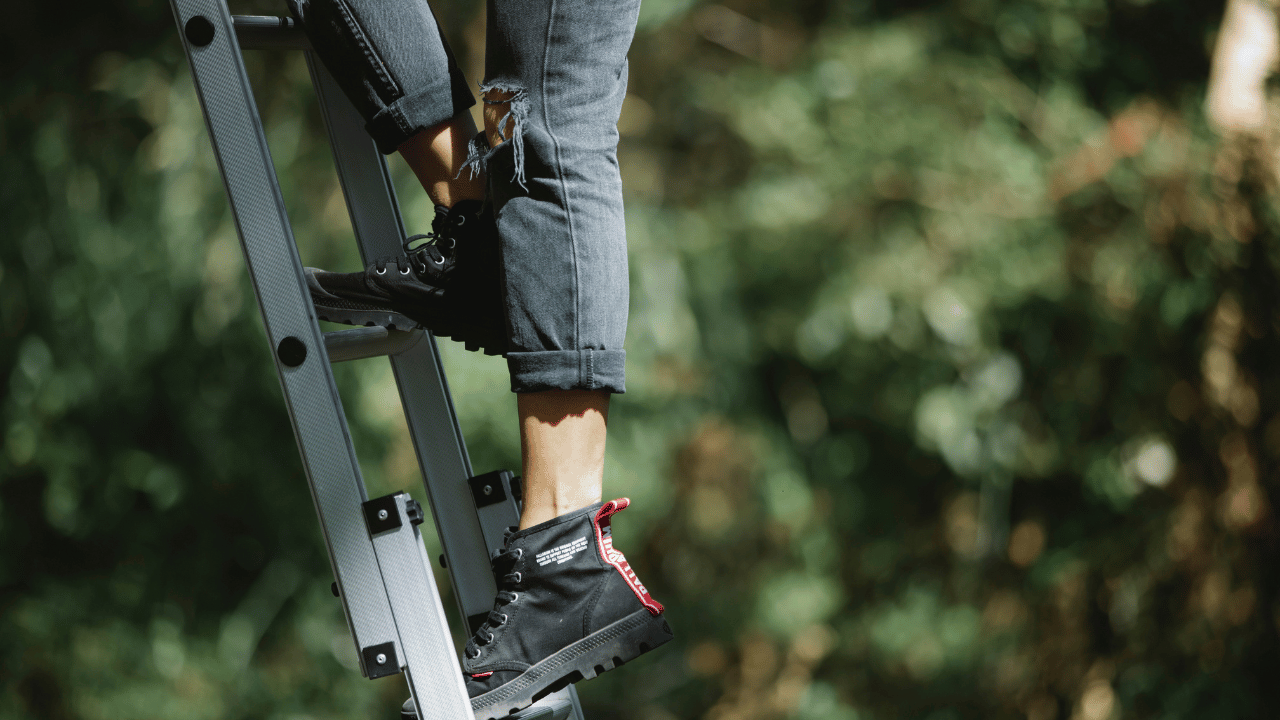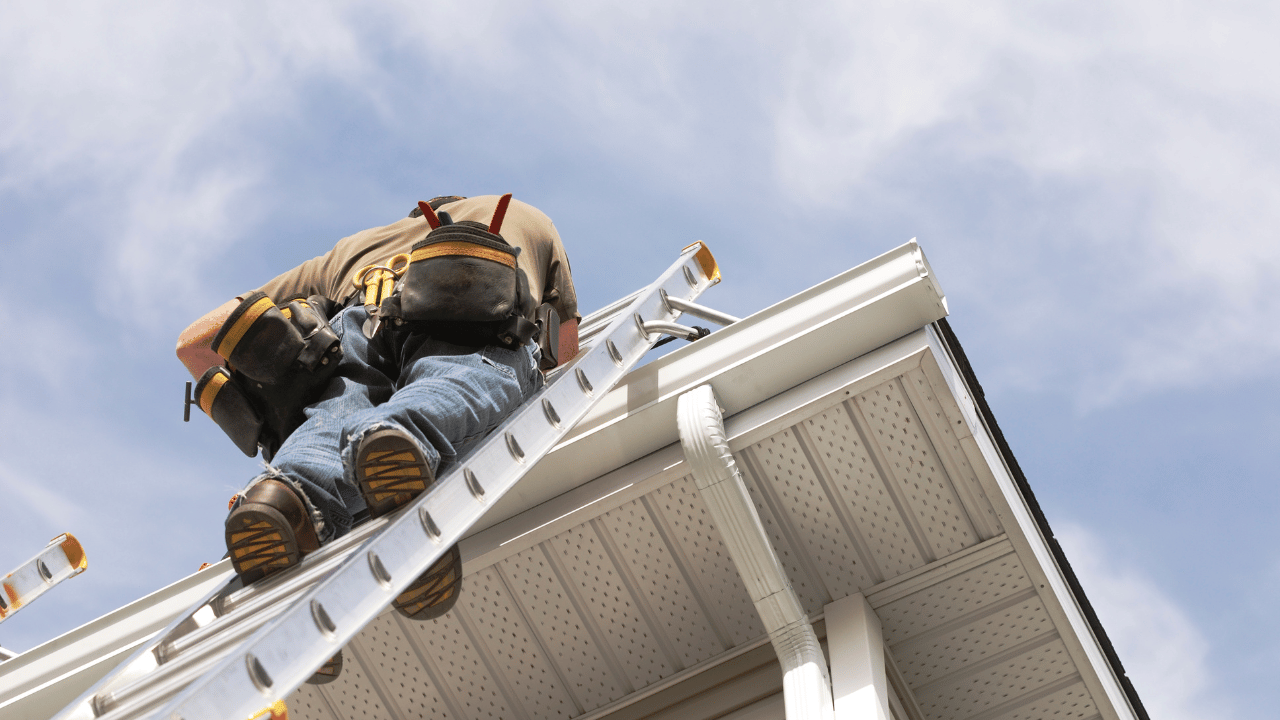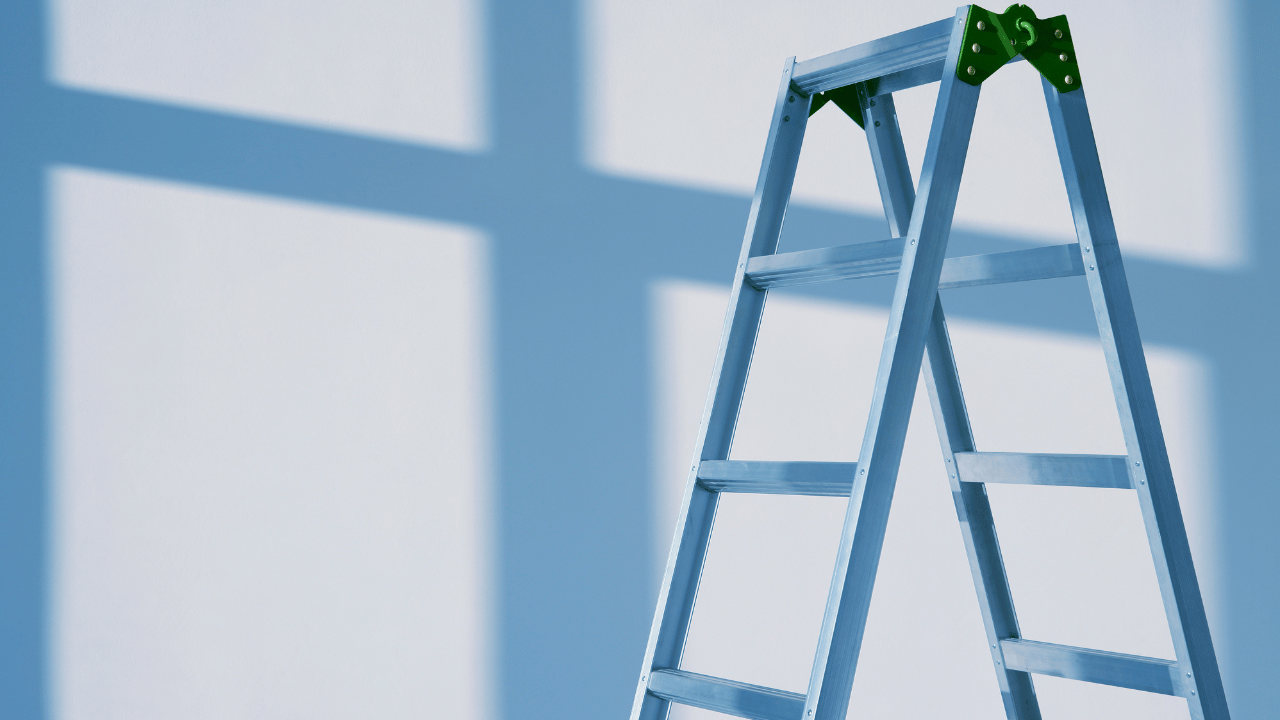Last Updated on September 7, 2023 by Pro Handyman Australia – Editorial Team
While home-improvement shows might glorify the transformation of homes, they often leave out the risk of ladder-related injuries. Human error accounts for some of these incidents, but in other cases, the ladder design may be the culprit. Annually, about 175,000 visits to the emergency room can be attributed to ladder-related accidents. Therefore, ensuring that your ladder is reliable and safe is crucial.
Selecting a Sturdy Ladder
Residential ladders usually come with a label specifying the maximum weight they can bear. Given the unpredictability of who might use the ladder in a household setting, it’s wise to opt for ladders that boast a weight capacity of at least 300 pounds (Type 1A). The peace of mind provided by this added safety margin justifies any additional cost or weight.
Understanding the Importance of Ladder Safety
Safety should always be a top priority when working with ladders. A ladder is not just a simple tool; it’s a vital equipment piece that must adequately support the user’s weight and anything they might be carrying. These tools are built with a wide base and adjustable feet to ensure stability even on uneven terrains like grass. If your current ladder shows signs of wear, such as wobbly rungs or significant rusting, it’s prudent to invest in a new one rather than attempting risky repairs.
The primary purpose of a ladder is to offer balance and support to the user, making it essential to own a trustworthy ladder that doesn’t betray your trust during crucial moments. Recent statistics from the CDC indicate that ladder-related injuries result in over 500,000 treatments every year. More alarmingly, 300 of these cases result in fatalities. Such data underscores the importance of being serious about ladder safety.
Factors to Keep in Mind When Purchasing a Ladder

Height and Positioning
One of the initial aspects to consider while searching for a ladder is its height or reach. Remember that for a safe ascent, the ladder should be angled so that there’s no risk of it toppling backward. Therefore, the ladder’s length or height should surpass the roof’s height it’s intended to reach. A safe climbing angle is usually within the 70-75 degree range. Furthermore, once the ladder is set up, it should overshoot the roof’s edge by a minimum of three feet. This ensures the user can easily transition on and off the ladder.
Understanding Weight Capacities
Ladders, like most equipment, have a specified weight limit they can handle. The weight capacity varies based on the ladder’s intended use. For instance, a ladder meant for light household chores might only bear up to 200 pounds, whereas one crafted for professional construction tasks can withstand up to 375 pounds. This weight limitation encompasses not just the individual’s weight but also any tools or materials they might carry.
When discussing weight capacities, one can classify ladders based on their duty ratings:
- Type III: An economical choice designed for lightweight tasks with a 200 lbs. weight limit.
- Type II: Perfect for straightforward tasks with a weight limit of 225 lbs.
- Type I: Crafted to manage a wide range of tasks, supporting up to 250 lbs.
- Type IA: Made for professional use, offering a rugged performance with a 300 lbs. weight limit.
- Type IAA: The pinnacle of ladder design, ensuring maximum durability and support for up to 375 lbs., ideal for demanding professional and home projects.
Evaluating Ladder Mobility
Historically, ladders were robust, heavy wooden structures that provided reliable support but were cumbersome. Nowadays, modern materials like aluminum and fiberglass provide the much-needed maneuverability without compromising on safety. For individuals using a ladder occasionally, like retrieving holiday decorations from the roof, the ease of movement might not be paramount. However, for those frequently using ladders indoors or for outdoor tasks like tree trimming or gutter maintenance, choosing a ladder that is both sturdy and easily movable becomes essential. Telescopic ladders, for instance, are as tall as extension ladders but collapse conveniently, making them both space-saving and more maneuverable.
Distinguishing Among Various Ladder Types

Single-Section Ladder:
This is the quintessential ladder with two supportive feet, two rails on either side, and evenly placed rungs for ascending. It leans directly against a surface. An essential guideline for safety is the 1 in 4 rule, which recommends placing the ladder’s base a foot away from a structure for every four feet of its height.
Stepladder:
Perfect for indoor tasks, stepladders possess an A-frame design. While one side has rungs for climbing, the other provides support. Notably, stepladders are self-supporting and fold compactly when not needed.
Extension Ladder:
An advanced version of the single-section ladder, extension ladders consist of two or three connected sections. These sections cascade out and lock in place. Their extendable nature offers more reach, but they can be slightly challenging to handle due to their size.
Telescopic Ladder:
These are the answers to the maneuverability issue with extension ladders. They extend to give increased reach, but post-task, they retract into a compact size, easing the challenges of transportation and storage.
Multi-Function Ladder:
Though not a common household tool, it’s invaluable at busy work locations. Its defining feature is the lockable hinge joints and ladder segments that can be configured in various ways, such as forming an A-frame stepladder, acting as an extension ladder, or even serving as scaffolding support.
Considering the Cost Factor
Investing in a quality ladder might seem hefty initially, but given their longevity of up to 20 years, it’s a worthy investment. Generally, single-section, extension, and telescopic ladders range between $100 to $300, with certain heavy-duty types being pricier. Multi-function ladders are premium and can reach up to $600. In contrast, stepladders, being smaller, cost between $50 to $200 based on their length.
It’s tempting to gravitate towards cheaper options available on some online platforms. However, it’s crucial to remember that a ladder’s primary role is to bear your weight safely at elevated heights. Prioritizing quality and safety over saving a few dollars might be the best route to take. Investing a bit more can guarantee a product that stands the test of time and safety.
Assessing Your Ladder Needs
When looking for a ladder to cater to your home projects, it’s crucial not to rush the decision. The type of work, be it indoor or outdoor, determines the kind of ladder you’ll require. Should you be in doubt, consider these guiding questions to help refine your options.
Determining the Right Ladder Type
There’s a vast array of ladders available, each catering to specific needs. For most homes, single-section ladders or stepladders suffice. However, if you’ve got tasks like cleaning gutters or roof maintenance, you might need to look into extension or telescopic ladders. While most homeowners might not find an immediate use for multi-function ladders, professionals like electricians or carpenters find them indispensable due to their adaptability.
Accounting for Weight Capacities
While height accessibility is a ladder’s primary function, it’s equally crucial to consider its weight-bearing capability. The ladder should comfortably accommodate your weight plus any equipment or items you might carry. Contemporary ladders come in various weight ratings, starting from 200 pounds for occasional domestic use to robust ones accommodating up to 375 pounds, catering to professional needs. Always check the ladder’s specifications and choose one that aligns with your requirements.
Gauging the Optimal Height
A ladder’s height is undeniably one of its most defining features. For indoor chores, think about the height of your kitchen cabinets, top shelves, or any high fixtures. When the focus shifts outdoors, say for roof-related tasks, opt for a ladder that projects at least three feet above the roof’s peak. This additional height ensures safer mounting and dismounting, especially when transitioning between the ladder and the roof.
Ladder Features and Considerations
Once you’ve settled on the type of ladder that suits your needs, it’s essential to dive deeper into specific features that can enhance its utility and safety.
Material Matters
While aluminum ladders offer the advantage of being lightweight, they do conduct electricity. This makes them a risky choice near power lines or any other electrical sources. In such situations, opt for fiberglass or wooden ladders, which offer better insulation. Nevertheless, irrespective of the material, it’s worth noting that a ladder can become a conductor when wet. Thus, always ensure your ladder is dry before use.
Optimal Size for Safety
Select a ladder that provides an appropriate height for your tasks. It’s essential to avoid situations where you overstretch or use the ladder in ways that compromise its stability. Specifically, refrain from climbing beyond the recommended maximum height mentioned on the ladder, as this heightens the risk of accidents. For tasks involving rooftops, ensure the ladder extends a minimum of three feet above the roofline or the intended working surface.
Enhancing Your Ladder: Features and Add-Ons

As you consider your ladder options, it’s worth exploring additional features and accessories that can make your tasks safer and more efficient. Each enhancement has its unique benefits tailored to specific needs and ladder types.
Integrated Work Shelves
Some step ladders boast an integrated platform or folding work shelf, providing a handy space for your tools and materials. For those that don’t, there are aftermarket trays, platforms, paint cups, and even buckets designed to be compatible with certain ladder models.
Tool Holding Solutions
Many modern step ladders come with dedicated notches and holes to keep tools within arm’s reach. For added convenience, bungee loops are available, ensuring your tools remain secure and easily accessible.
Leveling Systems for Uneven Ground
If you often work on uneven surfaces, consider extension ladders equipped with a leveling system. While some models come with a built-in bubble level for precise adjustments, others might require separate levelers. These attachments not only ensure safety but also provide confidence in the ladder’s stability.
Sturdy Feet for Ground Stability
Certain extension ladders come with serrated-edged feet, allowing them to grip and anchor into the ground, enhancing stability, especially on softer terrains.
Ladder Stabilizers
Stabilizers are crucial accessories for extension ladders, especially when spanning wide surfaces like windows. By attaching to the ladder’s top, stabilizers broaden the ladder’s support points, ensuring greater stability and safety.
Protective End Covers
Foam end covers, designed for extension ladders, play a protective role, preventing potential damage to walls from the ladder’s top edge.
Carrying and Storage Solutions
For those who own telescoping ladders, carrying cases are invaluable. Not only do they shield the ladder from potential damage, but they also simplify transportation. Additionally, consider investing in specially designed storage hooks or hangers. These devices help store ladders efficiently, keeping them elevated and out of the way.
Temporary Scaffolding Options
If you’re in need of a makeshift scaffolding stage, ladder jacks are your answer. By attaching supports to two extension ladders, you can create a stable and temporary platform. Just remember, constructing such a stage requires a pair of jacks and two compatible ladders.
Understanding the 1 in 4 Rule for Ladders
When setting up a ladder, it’s vital to follow the 1 in 4 rule to ensure optimum stability. This rule advises that for every four feet of vertical ascent against a building, the ladder’s base should be positioned one foot away. To illustrate, if the rooftop or working height is approximately 12 feet, the ladder base should be three feet from the building.
Identifying Main Causes of Ladder Accidents
Contrary to popular belief, ladder mishaps often aren’t due to equipment flaws like a loose rung. Instead, human error is the predominant cause. Such mistakes encompass placing the ladder on uneven ground, lugging heavy toolboxes up and down, or overreaching from the ladder, especially from its top rung.
Preventing Ladder-Related Accidents
Prevention is better than cure. Before using your ladder:
- Thoroughly inspect it to confirm it’s in optimal condition.
- Adhere to the 1 in 4 rule when setting it up.
- Always maintain three points of contact during the climb.
- Refrain from using the ladder’s topmost rung as a stepping point.
- Ensure the ladder is on a steady, even foundation.
- Employ a spotter to stabilize the ladder, and they can also provide immediate assistance if an emergency arises.
Safety Tips for Effective Ladder Use
Safety should be paramount, regardless of the task at hand. Here are essential tips to ensure your safety while using a ladder:
Routine Inspection and Maintenance
- Prioritize cleaning off any slippery substances from the ladder’s steps and rails before usage.
- Regularly check and tighten any hinges, reinforcing rods, and bolts, ensuring not to overstrain them.
- Examine extension ladders for wear and tear, particularly around the locks, hinges, and lanyards.
- When assessing ladder conditions, look out for dents in aluminum ladders, cracks in fiberglass ones, and splits or loose rungs in wooden ladders. Any of these defects call for an immediate replacement.
Appropriate Setup
- Only utilize a ladder for its intended purpose. Never lay it horizontally as makeshift scaffolding unless it’s specifically designed for that role.
- Deploy stepladders in a completely open arrangement, locking the spreaders.
- Ensure ladders rest on sturdy, level terrains. Refrain from using makeshift solutions, like rocks or lumber, for leveling purposes.
- Always be wary of surrounding hazards, like power lines or pedestrian traffic.
- Observe the appropriate ladder angle; for example, a 12-foot ladder should have its base 3 feet from the wall.
Safe Utilization
- Avoid ladder use during unfavorable weather conditions.
- Ascend and descend with caution, always facing the ladder and maintaining a steady grip.
- Don’t overreach; keep your weight centered.
- Never “walk” the ladder to a different location while still atop it or allow another person on it simultaneously.
- When working with cumbersome tools, it’s advisable to lower them or have them handed over rather than carrying them up.
Protecting Your Ladder
- Store ladders in places shielded from harsh elements. For instance, fiberglass ladders should be kept away from direct sunlight.
- Indoor ladder storage not only prolongs its lifespan but also safeguards your home by preventing unauthorized access to upper floors.
Conclusion
In the realm of household tools, a ladder might seem like a simple, unassuming instrument. However, as we’ve unraveled in this guide, the complexity and significance of making the right ladder choice cannot be understated. From understanding the nuances of materials used, to recognizing the imperative role of features, and more, buying a ladder is an investment in both functionality and safety.
A ladder is more than just a tool; it’s a gateway to inaccessible places, a bridge to heights, and a means to accomplish tasks that would otherwise be out of reach. From simple domestic chores to more intricate professional tasks, the ladder you choose plays an integral role in ensuring that each job is executed with precision and care. Beyond mere utility, the right ladder serves as a guardian, providing stability and security with each step you take. This makes the ladder-buying process not just about cost or convenience, but about ensuring you’re equipped with an apparatus that complements your tasks while prioritizing your safety.
Moreover, the expansive variety of ladders available today – from step ladders to extension ladders, and from aluminum to fiberglass – indicates that there’s a perfect ladder out there for every individual and every job. But this variety also underscores the importance of being informed. An informed decision is a safe decision. As with many tools and equipment, the adage ‘one size fits all’ simply doesn’t apply here.
It’s our hope that this guide has illuminated the path towards finding that perfect ladder tailored to your needs. Remember, the ladder you select is a reflection of your commitment to quality, safety, and efficiency. So, whether you’re painting a mural, fixing a roof, or just fetching a book from the topmost shelf, let your ladder be a steadfast partner in every climb.
